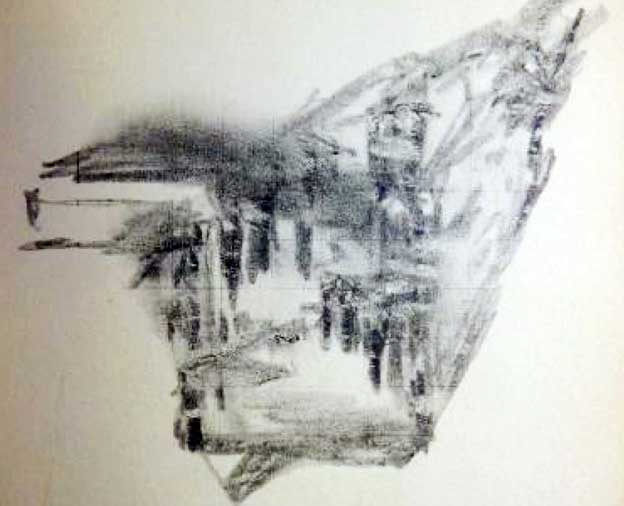MÔMO
After Antonin Artaud's 'Artaud le Mômo' (1947) and 'Dossier d'Artaud le Mômo' (1974)

MÔMO is based on Antonin Artaud’s radical poetry book Artaud le Mômo[1] (section I below), which includes five short poems: “Le retour d’Artaud, le Mômo,” “Centre-Mère et Patron-Minet,” “Insulte à l’Inconditionné,” “L’Exécration du père-mère,” and “Aliénation et magie noire” (and the manuscripts contain many variations that were published afterwards in Dossier d’Artaud le Mômo [II–XVIII below]). Antonin Artaud — a famous French poet and playwright — wrote this book between July and September of 1946. He had just left the psychiatric asylum of Rodez in May 1946, after three years of internment.
Prophetic, Artaud already affirmed in his essay The Theater of Cruelty (1938) the importance of recovering “[…] the notion of a kind of unique language halfway between gesture and thought.”[2] In this vein, Artaud le Mômo is punctuated by “glossolalia,” an invented speech he often used in his poems at this time. Discussing Artaud’s “glossolalia,” Anne Tomiche says: “Artaud does not hesitate to seem delirious, but it is to make hear the delirium of language, a language that is not French while departing nevertheless from French: ‘the humming / chanted, secular, non-liturgical, non-ritual, non-Greek, Black, Chinese, Indian, and French villon.’”[3]
In order to write my own synthetic portrait of Artaud, I “erased” everything from Artaud le Mômo and Dossier d’Artaud le Mômo but his “glossolalia.” Following Robert Rauschenberg’s Erased de Kooning Drawing (1953), Christine Kozlov’s Tape Recorder (Erasure) (1970) (“[…] a tape recorder that recorded all the audible sounds in the exhibition room in a process of erasure and replacement every two minutes to address the effects of the exhibiting environment”[4]), Joseph Kosuth’s Zero and Not (1986–89) (that partially obliterates Sigmund Freud’s texts), and Kenneth Goldsmith’s “Gertrude Stein on Punctuation” (1999) (“which consist solely of the punctuation marks taken from Stein’s essay “Poetry and Grammar”[5] [1935]), my idea was to focus on Antonin Artaud’s “unique language” and examine madness by adopting a “cruel”[6] and in some way “extreme” or “parricidal” strategy —“half-way between gesture and thought”— appropriated from this so-called “rational” and/or “mystical” art (as Sol LeWitt would say), called conceptual art.
I
o dedi
a dada orzoura
o dou zoura
a dada skizi
o kaya
o kaya pontoura
o pounoura
a pena
poni
ge re ghi
regheghi
geghena
e reghena
a gegha
riri
menendi anenbi
embenda
tarch inemptle
o marchti rombi
tarch paiolt
a tinemptle
orch pendui
o patendi
a merchit
orch torpch
ta urchpt orchpt
ta tro taurch
campli
kot i aunch
aungbli![]()
klaver striva
cavour tavina
scaver kavina
okar triva
![]()
farfadi
ta azor
tau ela
auela
a
tara
ila
![]()
II
lingam
o dedi
a dada ourzourou
o dourzoura
a dada oudo
o karfa
o karfa
potoura
o poutoura
a perta
ponou
garebi derebi
rebusa
garebusa
a reba
rebi
vavazi vavazi tauedooudo
vavazi tauedoudo
o die
![]()
III
o dedi
o dada orzouro
a dada
skizi
o karfa
a karfa
pontouro
o pontouro
a penta
poni
gerebi rerebi
gegehna
regehgehna
e ghebi
riri
ram de mouzou
di aroutilla
ca da rou tilla
ca de mou mou
lar re la gren
re ni ta gren
eni ta gren
eri pipi
vavazi vavazi tairendo
vavazi tairendo
o crazi
narch mendi
a diporcht inemptle
u dinemptle
crorch u menti
entorch
march mendi
u ti norcht inemptl
a tinemptl
orkh menenti
orch toch
![]()
IV
ram den mouzou
di arvadila
arvadila
cadem moum
lar na la grene
eni
larg la grene
a la la greni
en jambi
![]()
V
raidak narld nok
raidel dagord
zelbidi
zedel bidi
![]()
VI
dokeldind
da lutuor
onkouza
da nan kouza
a tuta kedi
![]()
VII
ekr
fruta
barilla
a barille
ekr
frutra
brectra
![]()
VIII
elanspkir
gelanski
zarouli
e le roula
e la roula
e la gastanski
![]()
IX
into capur
fele castire
ati caspira
bele kipu
![]()
X
into capur
fela castire
ati caspira
bele kipu
![]()
XI
mainzer tarapt ebe napti
![]()
XII
amoner omoni
omi omi
igno mini
tragoula arjula
icaria
rida dana
arajule
boule zadur
zadir
edela
bula edela
artedra
bula tatra
tratra redela
bula
edele
artedra
erebudela
abernetra
![]()
XIII
nu nu
matru
![]()
XIV
staver striva
cavour tavina
staver kavina
okar triva
![]()
XV
tandur egash
aza tardede
abatardo
tandur ezede
abatardo
kha dou
khouda
khounde davagu
ounde
datro
khadou
khoundangu
khounde
datro
![]()
XVI
madela
dam
bella varina
madelina
da vela bere
cta bur deou
ya burda
ezuta
(ya ezuta
a berda buza)
a berzutu
a burda uza
cta bezuta
a burda uza
![]()
XVII
mainiur jambide
mainia jambo
o i o o i d e a
o i o o o
![]()
XVIII
faidiodo
koodo
faidido
komilo
failildo
koptildo
volmildo
kolo
fautelebo
koptreldo
autreldo
komerlo
zauneldo
koleldo
kaubeldo
koptlo
komelsi
farfadi
taazor
taueela
auela
a
tara ila
![]()
1. Antonin Artaud, Œuvres complètes XII (Artaud le Mômo, Ci-Gît précédé de La culture indienne) (Paris: Éditions Gallimard, 1974), 13–20, 101–224.
2. Antonin Artaud, The Theater and Its Double, trans. Mary Caroline Richards (New York: Grove Press, 1958), 89.
3. Anne Tomiche, “Glossolalies: du sacré au poétique,” Revue de littérature comparée 1, no. 305 (2003), 72. My translation.
4. Eve Kalyva, Image and Text in Conceptual Art: Critical Operations in Context (Basingstoke: Palgrave Macmillan, 2016), 71.
5. See Kenneth Goldsmith’s biography page.
6. “But ‘theater of cruelty’ means a theater difficult and cruel for myself first of all.” Antonin Artaud, The Theater and Its Double, trans. Mary Caroline Richards (New York: Grove Press, 1958), 79.
Edited by Divya Victor